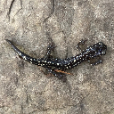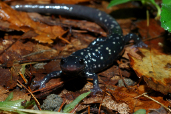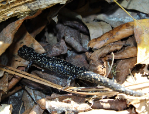Northern Slimy Salamander (Plethodon glutinosus)
Description: The northern slimy salamander is typically an overall black in color, with numerous silvery spots or gold spots across its back. It is usually 4.7 to 6.7 inches in total length (including tail), but can grow to 8.1 inches. Males are not easily distinguished from females, though females tend to be slightly larger.
Habitat: P. glutinosus is highly associated with moist undisturbed woodlands, and ravines. The salamander is typically located on the underside of debris such as logs and stones during the day. P. glutinosus will emerge from debris on moist nights. They can be found in areas of secondary succession in old growth deciduous or hemlock forests with steep, rocky slopes. They prefer hiding under rotten logs and in decomposed organic matter like layers of duff on the forest floor. They can typically be found near a water source or in a moist areas. The clear-cutting of forests greatly reduces population numbers in the given area, where it takes 13 years for the population to return to half of what it was before the clear-cutting.
Range: P. glutinosus is found from New York, west to Illinois, south to Mississippi, and east to Alabama, with isolated populations in southern New Hampshire and northwestern Connecticut.
Diet: Not much is known about the diet of the slimy salamanders, but it is believed that the species exhibit opportunistic feeding strategies where they consume prey that is easily accessible. One study surveyed the digestive systems of this species and found that ants, bees, wasps, beetles, sowbugs, snails, and earthworms occurred most frequently.
Reproduction: Females reach sexual maturity in the second year of life and do not lay eggs until the third year. Breeding of P. glutinosus takes place in the spring and is terrestrial. Courtship consists of the males performing a sort of dance to attract the females' attention. Females lay clutches of four to 12 eggs in a moist area, which she guards, often neglecting food for the period until they hatch. Hatchlings emerge from the eggs in about three months, having no aquatic stage, like many other salamander species. They instead develop directly into their entirely terrestrial adult form. After hatching, young individuals show high growth rates during the summer months and little to no growth during the winter.
Status: Listed as Least Concern in view of its wide distribution and presumed large population.
»» Kingdom: Animalia - Animals
»» Phylum: Chordata - Chordates
»» Subphylum: Vertebrata - Vertebrates
»» Class: Amphibia - (Amphibians)
»» Order: Caudata - Salamanders
»» Family: Plethodontidae - Lungless Salamanders
»» Genus: Plethodon
»» Species: Plethodon glutinosus - Northern Slimy Salamander
This article uses material from the Wikipedia article "Northern Slimy Salamander", which is released under the Creative Commons Attribution-Share-Alike License 3.0. Content may have been omitted from the original, but no content has been changed or extended.
|













